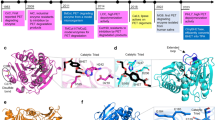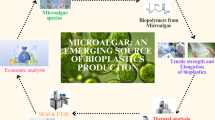Abstract
Due to the scarcity of resources, alternatives to non-renewable resources have become more important. Chemical catalysts react violently and the conditions are harsh. Using biocatalysts at the water/oil (W/O) interface remains technically challenging and is rewarding. In this study, the Thermomyces lanuginosus lipase-poly coupling biocatalyst was prepared by the atom transfer radical polymerization “grafting-from” method. The TL–PNIPAAm conjugate was successfully prepared and circular dichroism showed a negligible change between the free enzyme and conjugated enzyme by sodium dodecyl sulfate–polyacrylamide gel electrophoresis and transmission electron microscopy. Furthermore, the temperature and pH stability of the conjugate was better than that of free TL. The remaining activity of the TL–PNIPAAm conjugate for 10 h was approximately 20% higher than that of free TL after heat treatment (55 °C) and higher pH stability was obtained in the pH 4–10. The remaining activity of the TL–PNIPAAm conjugates was above 60% after recycling 7 times. In addition, the conversion of biodiesel from kitchen waste oil was 92.6% at 50 °C for 25 h with a conversion efficiency of 0.04 g/mL/h. Thus, a high stability and reusability biocatalyst and stabilizer at the interface of water-in-oil Pickering emulsions was successfully prepared.
Graphical Abstract







Similar content being viewed by others
Data Availability
Data available within the article or its supplementary materials.
References
Hossain, M.N., Bhuyan, M., Alam, A., Seo, Y.C.: Optimization of biodiesel production from waste cooking oil using S-TiO2/SBA-15 heterogeneous acid catalyst. Catalysts 9, 1 (2019)
Zhou, G.X., Chen, G.Y., Yan, B.B.: Biodiesel production in a magnetically-stabilized, fluidized bed reactor with an immobilized lipase in magnetic chitosan microspheres. Biotechnol. Lett. 36, 63–68 (2014)
Felix, C., Ubando, A., Madrazo, C.: Investigation of direct biodiesel production from wet microalgae using definitive screening design. Energy Procedia 158, 1149–1154 (2019)
Chen, C.Y., Li, D.S., Sun, N., Ma, X.F., Xiao, G.Q., Zhou, J.: Oil recovery from drilling cuttings by biosurfactant from kitchen waste oil. Energy Source Part A 43, 314–325 (2021)
Patsalou, M., Chrysargyris, A., Tzortzakis, N.: A biorefinery for conversion of citrus peel waste into essential oils, pectin, fertilizer and succinic acid via different fermentation strategies. Waste Manage. 113, 469–477 (2020)
Paul, A.A.L., Adewale, F.J.: Data on optimization of production parameters on persea americana (Avocado) plant oil biodiesel yield and quality. Data Brief. 20, 855–863 (2018)
Wan, Y., Zheng, C.C., Lei, X.C, Lei, X.C., Zhuang, M.Q., Lin, J.H., Hu, W.D., Lin, J.D., Wan, S.L., Wan, Y.: Oxidative esterification of acetol with methanol to methyl pyruvate over hydroxyapatite supported gold catalyst: Essential roles of acid-base properties. Chin. J. Catal. 40, 1810–1819 (2019)
Zhang, B.B., Weng, Y.D., Xu, H., Mao, Z.P.: Enzyme immobilization for biodiesel production. Appl. Microbiol. Biotechnol. 93, 61–70 (2012)
Mateo, C., Palomo, J.M., Fernandez-Lorente, G.: Improvement of enzyme activity, stability and selectivity via immobilization techniques. Enzyme Microb. Technol. 40, 1451–1463 (2007)
Ben, L.K., Daud, W., Ghasemi, M., Leong, J.X., Lim, W.S., Ismail, M.: Non-Pt catalyst as oxygen reduction reaction in microbial fuel cells: a review. Int. J. Hydrogen Energ. 39, 4870–4883 (2014)
Chen, C., Ng, D.Y.W., Weil, T.: Polymer bioconjugates: modern design concepts toward precision hybrid materials. Prog. Polym. Sci. 105, 101241 (2020)
Kovaliov, M., Cheng, C., Cheng, B.: Grafting-from lipase: utilization of a common amino acid residue as a new grafting site. Polym. Chem. UK 9, 4651–4659 (2018)
Wang, Y., Wu, C.: Site-specific conjugation of polymers to proteins. Biomacromol 19, 1804–1825 (2018)
Sołowiej, B.G., Nastaj, M., Szafrańska, J.O.: Effect of emulsifying salts replacement with polymerised whey protein isolate on textural, rheological and melting properties of acid casein model processed cheeses. Int. Dairy J. 105, 104694 (2020)
Zhu, B.B., Lu, D.N., Ge, J., Liu, Z.: Uniform polymer–protein conjugate by aqueous AGET ATRP using protein as a macroinitiator. Acta Biomater. 7, 2131–2138 (2011)
Nady, D., Zaki, A.H., Raslan, M.: Enhancement of microbial lipase activity via immobilization over sodium titanate nanotubes for fatty acid methyl esters production. Int. J. Biol. Macromol. 146, 1169–1179 (2020)
Kim, J.Y., Lee, B.S., Choi, J.: Cytocompatible polymer grafting from individual living cells by atom-transfer radical polymerization. Angew. Chem. Int. Ed. 55, 15306–15309 (2016)
Wang, Y., Fantin, M., Matyjaszewski, K.: Synergy between electrochemical ATRP and RAFT for polymerization at low copper loading. Macromol. Rapid Commun. 39, e1800221 (2018)
Mendonça, P.V., Averick, S.E., Konkolewicz, D.: Straightforward Arget ATRP for the synthesis of primary amine polymethacrylate with improved chain-end functionality under mild reaction conditions. Macromolecules 47, 4615–4621 (2014)
Hu, Y., Shi, C.Y., Xun, X.M., Huang, B.R., You, S., Wu, F.A., Wang, J.: Xylanase-polymer conjugates as new catalysts for xylooligosaccharides production from lignocellulose. Biochem. Eng. J. 171, 108025 (2021)
Van Schie, M.M.C.H., Ebrahimi, K.H., Hagen, W.R.: Fast and accurate enzyme activity measurements using a chip-based microfluidic calorimeter. Anal. Biochem. 544, 57–63 (2018)
Teng, Y., Xu, Y.: A modified para-nitrophenyl palmitate assay for lipase synthetic activity determination in organic solvent. Anal. Biochem. 363, 297–299 (2007)
Gupta, N., Rathi, P., Gupta, R.: Simplified para-nitrophenyl palmitate assay for lipases and esterases. Anal. Biochem. 311, 98–99 (2002)
Yan, C.H., Xun, X.M., Wang, J., Wang, J.Z., You, S., Wu, F.A., Wang, J.: An alternative solution for alpha-linolenic acid supplements: in vitro digestive properties of silkworm pupae oil in a pH-stat system. Food Funct. 12, 2428–2441 (2021)
Zhou, X.J., Zhu, C.T., Hu, Y., You, S., Wu, F.A., Wang, J.: A novel microfluidic aqueous two-phase system with immobilized enzyme enhances cyanidin-3-O-glucoside content in red pigments from mulberry fruits. Biochem. Eng. J. 158, 107556 (2020)
Glassman, M.J., Olsen, B.D.: Arrested phase separation of elastin-like polypeptide solutions yields stiff, thermoresponsive gels. Biomacromol 16, 3762–3773 (2015)
Yao, M.L., Hua, X.F.: Enzyme–polymer hybrid nanocatalyst prepared by microemulsion polymerization. Catal. Lett. 144, 1240–1244 (2014)
Qu, Y.N., Huang, R.L., Qi, W., Qu, Q., Su, R.X., He, Z.M.: Structural insight into stabilization of pickering emulsions with Fe3o4@SiO2 nanoparticles for enzyme catalysis in organic media. Part. Part. Syst. Charact. 34, 1700117 (2017)
Yang, J.J., Ma, X.X., Zhang, Z.S., Chen, B., Li, S.A., Wang, G.J.: Lipase immobilized by modification-coupled and adsorption-cross-linking methods: a comparative study. Biotechnol. Adv. 28, 644–650 (2010)
Rahman, M.S., Brown, J., Murphy, R.: Polymer modification of lipases, substrate interactions, and potential inhibition. Biomacromol 22, 309–318 (2021)
Thushari, I., Babel, S.: Biodiesel production from waste palm cooking oil using solid acid catalyst derived from coconut meal residue. Waste Biomass Valori. 11, 4941–4956 (2020)
Razack, S.A., Duraiarasan, S.: Response surface methodology assisted biodiesel production from waste cooking oil using encapsulated mixed enzyme. Waste Manage. 47, 98–104 (2016)
Moovendhan, M., Vairamani, S., Shanmugam, A.: Utilization of cuttlefish liver waste for oil production: evaluation of quality characteristics and biological activity. Waste Biomass Valori. 10, 2959–2965 (2019)
Neto, C., Sydney, E.B., Candeo, E.S., de Souza, E., Camargo, D., Sydney, A., de Carvalho, J.C., Letti, L., Pandey, A., Soccol, C.R.: New method for the extraction of single-cell oils from wet oleaginous microbial biomass: efficiency, oil characterisation and energy assessment. Waste Biomass Valori. 11, 3443–3452 (2020)
Sadhukhan, S., Sarkar, U.: Production of biodiesel from Crotalaria juncea (sunn-hemp) oil using catalytic trans-esterification: process optimisation using a factorial and box-behnken design. Waste Biomass Valori. 7, 343–355 (2016)
Siddeeg, A., Xia, W.S.: Oxidative stability, chemical composition and organoleptic properties of seinat (Cucumis melovar tibish) seed oil blends with peanut oil from China. J. Food Sci. Technol. Mys. 52, 8172–8179 (2015)
Wang, C.M., Xie, S.Y., Zhong, M.X.: Effect of hydrothermal pretreatment on kitchen waste for biodiesel production using alkaline catalyst. Waste Biomass Valori. 8, 369–377 (2017)
Tang, X.Y., Niu, S., Zhao, S., Zhang, X.Y., Yu, H.M., Lu, C.M.: Synthesis of sulfonated catalyst from bituminous coal to catalyze esterification for biodiesel production with promoted mechanism analysis. J. Ind. Eng. Chem. 77, 432–440 (2019)
Ogata, T., Nagasako, T., Umeki, Y.: Synthesis, properties, and functions of thermosensitive copolymers having pyridyl and/or pyridinium groups. React. Funct. Polym. 67, 700–707 (2007)
Lapuerta, M., Rodríguez-Fernández, J., Estevez, C.: Properties of fatty acid glycerol formal ester (FAGE) for use as a component in blends for diesel engines. Biomass Bioenerg. 76, 130–140 (2015)
Wang, J.Z., Liu, X., Li, W.J., Song, W.M., Herman, R.A., Sheng, S., Wu, F.A., Wang, J.: One hour enzymatic synthesis of structure lipids enriched unsaturated fatty acids from silkworm pupae oil under microwave irradiation. J. Chem. Technol. Biotechnol. 95, 363–372 (2019)
Wang, J.Z., Wu, C.K., Yan, C.H., Chen, H., You, S., Sheng, S., Wu, F.A., Wang, J.: Nutritional targeting modification of silkworm pupae oil catalyzed by a smart hydrogel immobilized lipase. Food Funct. 12, 6240–6253 (2021)
Karmee, S.K.: Enzymatic biodiesel production from Manilkara zapota (L.) seed oil. Waste Biomass Valori. 9, 725–730 (2018)
Hu, Y., Shi, C.Y., Xun, X.M., Chai, Y.L., Herman, R.A., You, S., Wu, F.A., Wang, J.: W/W droplet-based microfluidic interfacial catalysis of xylanase-polymer conjugates for xylooligosaccharides production. Chem. Eng. Sci. 248, 117110 (2022)
Funding
This work was supported by the National Natural Science Foundation of China (Grant No. 21978121) and the 333 High-level Talent Training Project of Jiangsu Province (Grant No. BRA2019281).
Author information
Authors and Affiliations
Corresponding author
Ethics declarations
Conflict of interest
The authors have declared no conflicts of interest.
Additional information
Publisher's Note
Springer Nature remains neutral with regard to jurisdictional claims in published maps and institutional affiliations.
Supplementary Information
Below is the link to the electronic supplementary material.
Rights and permissions
About this article
Cite this article
Shi, CY., Hu, Y., Chai, YL. et al. Kitchen Waste Oil Convert to Biodiesel via W/O Interface Biocatalysis with Thermomyces Lanuginosus Lipase–PNIPAAm Conjugates. Waste Biomass Valor 13, 3945–3956 (2022). https://doi.org/10.1007/s12649-022-01735-8
Received:
Accepted:
Published:
Issue Date:
DOI: https://doi.org/10.1007/s12649-022-01735-8




